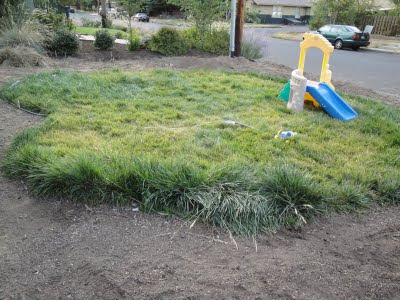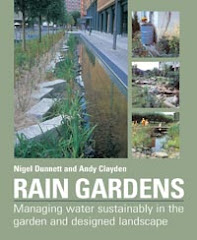For example, I have pots outside my entry door with tall sedums, creeping wire vine and Japanese Hakone Grass. Pots are very dangerous ventures for me since they dry out so fast. But get this, I can't remember when I watered them last. For real. Granted, I did add a lot of Soil Moist to the pots when I planted them, plus I added another Soil Moist sample product I got at the Farwest Show a month ago, but really, shouldn't they be half dead by now? Especially the Hakone Grass, but it's looking fine. I think this is all great and I can definitely recommend these plants to my clients.
But I digress.
What does all this have to do with lawns you ask? This is all in preparation to discuss the lawn that I currently have in my front yard. Disclaimer: Lawns are not the most sustainable and responsible thing to put in a landscape, they can require large amounts of fertilizer, polluting lawn mowers and irrigation and is a foreign plant material that does not benefit the local wildlife in any way. When I am looking at the potential of lawn in a landscape the questions I always ask are why, how much and what kind? I will now answer those questions in regards to my own landscape and my own lawn.
Why I have a lawn is because of a clean, nice place to play with my daughter. We have her slide and pool out there and the other day set up the tent for her to play in. I also like to sit out there and have picnic's.
I have a patch of lawn just big enough for all of these activities and I am actually considering modifying it a little bit, changing the shape to make it a more efficient shape for proper watering (so I don't water the dirt as much) and to just be really responsible about how much I really need, I do believe I could use less than what I currently have.
Many properties have their whole front yards in lawn but it is never used except as an expensive ground cover. This is a practice I am happy to report is changing to a more considerate approach to having and using lawns.
The kind of lawn I have is Turf Type Tall Fescue. Many people don't know that they have options but at least here in Central Oregon McPheeters Turf does sell this form of sod. You can of course get lots of other types of grasses in seed through Round Butte Seed Company and I highly recommend trying them out. I have a client who is doing his front yard in Chewings Fescue which he seeded over a month ago now and it's looking great. I'll post on that project later - so stay tuned in!
Back to the Turf Type Tall Fescue (TTTF for short). It is a thicker, hardier, more drought tolerant grass and is very appropriate for most of the landscapes around here. It is a little tougher to the touch and I do admit that I prefer the thinner bladed grass to sit on, but for all my needs, this is a perfect grass.
Here is picture of the TTTF:

And here is a picture of my neighbors regular Kentucky Blue Grass blend lawn:

See the difference in the thickness of the blades? The Kentucky Blue Grass is thinner and softer but has to be watered and mowed more often, it also requires more fertilizer. She doesn't use this grass in her front yard for more than a ground cover and a place for the dogs to roll around on so she could have put in TTTF instead.
Now I did more than just install TTTF in my front yard, I didn't fertilize it and I've watered it only once a week this whole season (except for during the heatwaves). I also have not mowed it more than four or five times. It does not look as good as my neighbor's lawn and I can do some environmentally friendly things to keep it looking better next year, but I am really impressed with how well it does look and has held up considering the "care" it has received.
Here is a picture of it I took yesterday:

You can see the yellowing of it, some good organic fertilizer will help with that, and you can see how it needs a good mowing, but also consider that it hasn't been mowed in over three months and it has stayed relatively short enough.
If you look at this and think to yourself, "I want to be more responsible but I really don't like the look of that," it's okay. It doesn't have to look like this, remember, this was an experiment. This is what it looks like when it is maintained properly:
The TTTF that is maintained looks and feels so much better than what I currently have, and I think I will do things differently for next year now that I have this experiment out of the way.
And yes, that is my lovely daughter Liliana who is 1 1/2 now. She does not come with the grass....
If you want to come over to see and to feel this option for lawn (or to discuss options for seeding other grass varieites), please drop me a line tanya@carlsengdesigns.com. Happy landscaping!
P.S. A further disclaimer, if you noticed in these pictures that my landscape doesn't have much going for it, you are right. My husband is a carpenter and we don't have windowsills in the house either.








